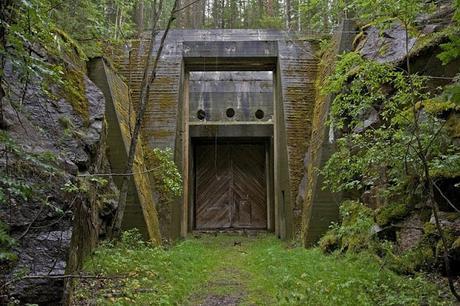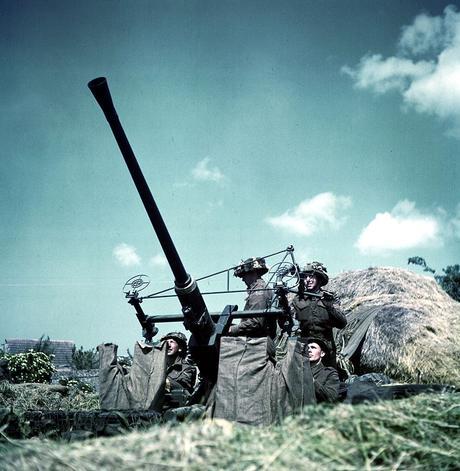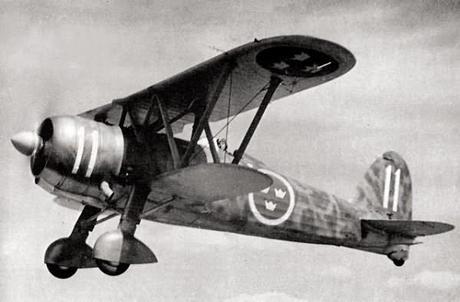posted by author Charles McCain www.charlesmccain.com

Abandoned World War Two bunker in Sweden. This one and many similar bunkers were built both for troop protection and as bomb proof electric substations.
According to the website below, on which I found the picture and the caption: “this is one of more than than fifty underground bunker substations built in Sweden during World War II. Concealing powerful generators, bomb-proof, cooled by underground rivers…”
http://www.darkroastedblend.com/2009/02/epic-abandoned-substations-and-power.html
A week ago I finished a second reading of Neither Friend Nor Foe: the European Neutrals in World War Two by J.M. Packard. I’m not certain this is the best book on the subject since there are some mistakes of fact about World War Two. However, what he mentioned about Sweden and its violation of neutrality laws was correct.
Sweden’s most significant violation of international law applicable to neutral countries in wartime was allowing German troops to transit Swedish territory. As time went on, the Germans ran regular troops trains with military supplies to occupied Norway overland on Swedish territory utilizing the Swedish state rail system.
Many of what we call “Laws of War” along with numerous regulations governing relations between neutrals and belligerent powers in wartime are spelled out in the Hague Convention of 1907 which has been amended many times.
You can find detail at the link below on the Convention Respecting the Rights and Duties of Neutral Powers and Persons in Case of War on Land (Hague V); October 18, 1907
http://avalon.law.yale.edu/20th_century/hague05.asp
You can find detail at the link below on: Laws and Customs of War on Land (Hague IV); October 18, 1907
http://avalon.law.yale.edu/20th_century/hague04.asp
The Swedes were in a rough neighborhood and in my view didn’t have a lot of choice but to accede to certain German demands. (The Swedish government did refuse some German demands. However, before officially refusing, they usually mobilized their entire military including reserves and put them on war footing).
German demands which the Swedes acceded to included huge exports of Swedish ball bearings and their famous iron ore which contains more iron per ton than any other iron ore in the world or any other iron ore in Europe. Other demands included Swedish manufactured weapons one being the outstanding medium range Bofors anti-aircraft gun.

The famous Swedish Bofors 40 mm anti-aircraft gun used by all sides in World War Two. (Once war came countries which could not get them directly from Sweden manufactured them under license. The gun above is being manned by British troops).
When you look at the map below you will see the only way Sweden could import food and other vital supplies was through the Swedish port of Goteborg.
If you look at the arrow, you will note that neutral ships carrying freight to Sweden had to go through the Skagerrak, a body of water completely controlled by the Germans. And if the Swedes want to import food and other supplies into Stockholm then you can see the very narrow bodies of German waters ships had to steam through. (Prior to sailing, all neutral ships carrying cargo to neutral countries had to be inspected by Allied contraband control officers and receive a “navicert” showing they were not carrying military cargo. There were other detailed regulations which had to be adhered to before one could receive a “navicert”).

On many occasions after the Germans had demanded something from the Swedes which violated international law, the Swedes would hesitate. The Germans would then graphically remind the Swedish government of the delicate geography of the Kingdom of Sweden by torpedoing Swedish freighters “by accident.” Since these ships were lighted up and steaming with running lights in specified sea lanes and broadcasting their position on a regular basis, sinking one “by accident” would be hard to do.
According to Neither Friend Nor Foe, forty Swedish freighters were sunk by German U-boats. Switzerland, by contrast, which had had purchased a fleet of merchant ships before the war to ship food to the Italian port of Genoa where it could be offloaded and trans-shipped on railways, didn’t lose one of its freighters.
The Swedes had to think about this interesting philosophical question: in his Second Treatise on Government, English philosopher John Locke wrote that the first duty of a state was to protect its citizens and their property most especially in time of war. Hence, wasn’t this the first duty of the Kingdom of Sweden?
So when the British and Americans complained to the Swedes for violating neutrality laws, the Swedes replied that they were surrounded by Germany and German dominated states and the British and Americans were a long way away. Swedish intelligence did favor the Allies, however, and provided useful information.
While Sweden had levied heavy taxes and spent most of its budget on its military during the war years, the Swedish forces would not have been able to stave off a German attack which we now know the Germans had planned to do.So what choice did they have but to give the bare minimum of cooperation they could to the Nazis? Not sure if they had much of a choice. It speaks well for Sweden that if you were an enemy of the Reich and could make to Sweden, they didn’t hand you over to the Germans. This included RAF and USAAF bombers which were damaged in raids over Germany and landed in Sweden. The Jews smuggled out of Denmark went to Sweden where they were protected and cared for although this annoyed the Nazis.
The Swedish military was strong enough to have caused the Germans a lot of trouble and a lot of casualties before succumbing and this persuaded the Germans that there wasn’t a lot of point in attacking Sweden since they could bet what they wanted without warring with the Swedes.

Royal Swedish Air Force Italian made Fiat CR 42 over Sweden circa 1942.
According t0 the website: www.ipmsstockholm.org/magazine
“The CR 42 came into Swedish service via Finland. During the winter war the Finish Air Force ordered a few CR 42 aircraft. They arrived too late to see service in the winter war and for some reason Finns sold them to the Swedish Air Force that was desperately short of modern materiel. The first 12 Finish CR 42s were complemented with more aircraft bought later, in total 72 aircraft did good service at F9 wing at Säve near Gothenburg and proved to be a popular and dependable aircraft even if it wasn’t exactly modern!”
Sweden had a difficult time securing modern weaponry they did not manufacture themselves such as aircraft. Ironically, because they did not want cash from the Germans since Reichsmarks were not convertible into other currencies, Swedes conducted most of their trade with the Third Reich through barter. One of the items they would receive from the Germans in return for their iron ore and other exports were German fighter planes.
